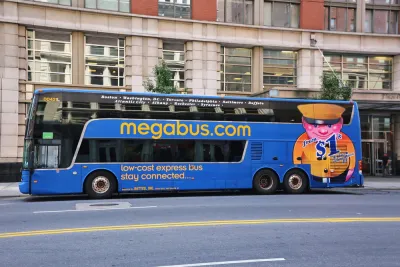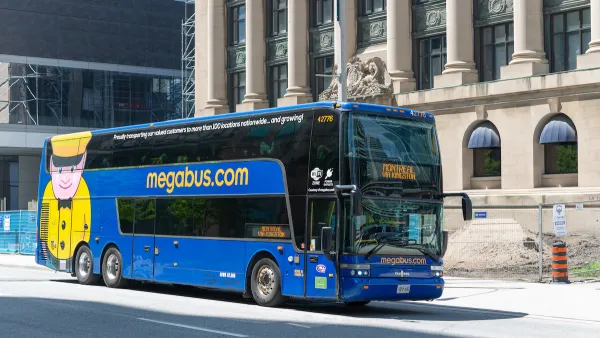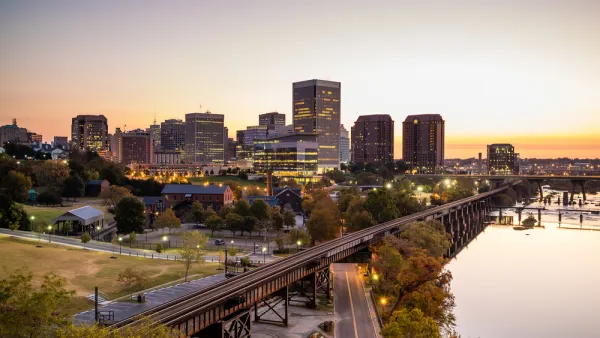Despite the popularity of intercity bus services, most users have to wait on unshaded sidewalks with none of the amenities of traditional bus depots.

"Bus travel has never gotten the same respect as rail," writes Inga Saffron, "[y]et, pre-pandemic, America’s long-haul buses carried twice the number of passengers as Amtrak." Inter-city buses "remain significantly cheaper than Amtrak and serve far-flung towns that have no train service. For low-income people, car-less single parents, college students, recent immigrants, and other budget-conscious folks living in Philadelphia, intercity buses are often the only way to go." But the companies that provide bus service use city sidewalks or parking lots to pick up riders, avoiding the "hefty docking fees" charged by traditional bus terminals. "A proposal for a more dignified bus terminal on the north side of 30th Street Station, first floated in Amtrak’s 2016 master plan, still hasn’t moved past the idea stage" and will take years to build. Because of this, Saffron argues, Philadelphia should take steps to make the sidewalk stops safe and comfortable.
Most sidewalk stops have "no canopy, no benches, no trash cans and, per usual, no restrooms," despite a recent pledge by city planners to place equity at the forefront of infrastructure decisions. Saffron sees this as an equity issue. "Where’s the equity in a bus stop that offers travelers nowhere to escape the elements?"
Although most policymakers don't see bus travel as an important part of a city's economy, writes Saffron, "bus service to New York, Washington, Penn State and beyond are part of what makes Philadelphia such an attractive place to live and do business." According to Deputy Commissioner Richard Montanez, "the best long-term solution would be for Philadelphia to consolidate all its downtown bus lines in one terminal on the parking lot north of 30th Street Station. But to make that project feasible, PennDot needs to realign the I-76 exit ramp leading to the train station," which could take years.
"The city doesn’t have time to wait," writes Saffron. "Thanks to the demand for life science labs, the area around 30th Street has become the city’s most significant job creator, the engine for its pandemic recovery." Nate Hommel, who oversees planning and design for the University City District (UCD), says the city needs a "comprehensive planning approach to intercity bus transportation" so those who depend on the service don't–literally–get "left out in the cold."
FULL STORY: Philly’s failure to improve conditions for intercity bus riders is an equity issue

Analysis: Cybertruck Fatality Rate Far Exceeds That of Ford Pinto
The Tesla Cybertruck was recalled seven times last year.

National Parks Layoffs Will Cause Communities to Lose Billions
Thousands of essential park workers were laid off this week, just before the busy spring break season.

Retro-silient?: America’s First “Eco-burb,” The Woodlands Turns 50
A master-planned community north of Houston offers lessons on green infrastructure and resilient design, but falls short of its founder’s lofty affordability and walkability goals.

Test News Post 1
This is a summary

Analysis: Cybertruck Fatality Rate Far Exceeds That of Ford Pinto
The Tesla Cybertruck was recalled seven times last year.

Test News Headline 46
Test for the image on the front page.
Urban Design for Planners 1: Software Tools
This six-course series explores essential urban design concepts using open source software and equips planners with the tools they need to participate fully in the urban design process.
Planning for Universal Design
Learn the tools for implementing Universal Design in planning regulations.
EMC Planning Group, Inc.
Planetizen
Planetizen
Mpact (formerly Rail~Volution)
Great Falls Development Authority, Inc.
HUDs Office of Policy Development and Research
NYU Wagner Graduate School of Public Service




























